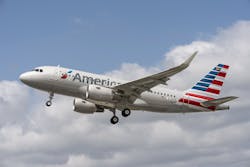Aug. 18--It was what American Airlines executives wanted in the beginning -- to emerge from bankruptcy as a leaner, stand-alone carrier shed of debt, pricey labor contracts and burdensome pension obligations.
And if the Department of Justice and Texas Attorney General Greg Abbott get their way, and scuttle the proposed merger with US Airways, the Fort Worth-based carrier will find itself getting just that --what it no longer hankers for.
So just how would American fare flying solo?
Actually, a lot better than before filing for Chapter 11 bankruptcy reorganization in November 2011, industry analysts and others say. But some contend that a tie-up with US Airways would still be preferable for long-term stability.
"It's in good shape to go it alone," says Mike Boyd, a Denver-based airline consultant. "A lot of its presence has atrophied east of the Mississippi, and the addition of the US Air system would have fixed that. But there's nothing lethal or terminal about AA as a stand-alone."
For starters, there's the cash on hand -- some $7 billion at the end of the second quarter, up from about $4.8 billion going into bankruptcy, says Basili Alokos, a Morningstar analyst. Boyd pointed out that American would emerge from Chapter 11 with lower costs than Dallas-based discounter Southwest, after negotiating new cost-cutting contracts with its unions, "and it's got labor peace, at least for the time being."
Moreover, it still has a good mix of profitable international routes and could dust off strategies from the original reorganization plan to do more code-sharing with JetBlue in the northeast and Alaska on the West Coast, where it is less competitive, noted industry consultant Henry Harteveldt of Hudson Crossing.
Of course, it would take some time rejigging the original bankruptcy plan if the airlines are not allowed to merge, said Mark Andrews, a Dallas bankruptcy attorney with Smith Cox.
"To go back to the old plan would require re-soliciting to obtain votes (from creditors), a cumbersome process," Andrews said. "That could take a considerable amount of time to obtain approvals of a changed plan by giving new disclosures and preparing new ballots, submitting the ballots and counting the votes. The financial circumstances change as well."
How long could it take? At the very least, Andrews said, a few months, assuming there are favorable court rulings and the creditors are on board. "Otherwise the process would be many months."
For now, the airlines are preparing for fight for their merger in federal court. Last week, the Department of Justice and six states, including Texas, filed a lawsuit in Washington, claiming that consumers would be hurt by higher fares and fewer choices if the carriers combined. Unless there's a settlement, the two sides would have to argue before a federal judge in Washington, putting the merger in jeopardy and possibly adding months to American's bankruptcy case.
Not everyone is optimistic about American's prospects on its own, especially in the future.
Former AMR Corp. CEO Robert Crandall conceded that the carrier is not in bad shape, "but it cannot succeed long term and will continue to be a shrinking entity" if the merger is nixed. "If American and US Airways don't succeed in creating greater mass and more ubiquity, they can't compete effectively against United and Delta," Crandall said in a statement relayed to the Star-Telegram.
After going back to the drawing board, a post-bankruptcy American, without US Airways, would become a smaller company with job losses and reduced capacity, predicted analysts Helane Becker and Conor Cunningham of Cowen Group.
"AMR needs to address its operations in (Los Angeles) and the overall network, which would result in capacity reductions and higher ticket fares," Becker and Cunningham said in a research note quoted by Bloomberg News, Barron's and others. "Worst-case scenario, AMR would need to liquidate, resulting in significant capacity and headcount reduction."
Still, others like Harteveldt believe a post-bankruptcy American, especially with strategic partnerships with other carriers, can make it on its own but not without peril.
"It needs to acquire more aircaft," he went on, "but there's risk if it orders too many to expand too aggressively, which could lead to fare wars. That's good for consumers, but not the airlines. There's definitely a fine line to be walked now.
"For American, it's like walking a tightrope in a very heavy windstorm," Harteveldt warned. "They've got a net -- their very solid bankruptcy reorganization plan."
One thing most observers agreed on is that rotten labor-management relations could easily be revived should American emerge from bankruptcy with the old leadership. American's three major unions threw their support behind a merger with US Airways early on and made it clear they prefer a new leader.
"I'm astonished how negative, how toxic, labor relations have become with the current management team," said analyst Vicki Bryan, of Gimme Credit, which researches corporate bonds, who recounted the controversy over executive bonuses after management wrested more than $1 billion in concessions from labor since 2003
Harteveldt agrees. "Clearly the unions wanted a change of leadership at the head of American. (US Airways Chief Executive) Doug Parker was viewed as the white knight riding in to save the airlines.
"There's nothing to stop AMR to come in and recruit Mr. Parker to run the airline should the merger be denied," he speculated. "But Parker is very attached to US Airways. If he feels it's wrong for him to leave US Airways, or doesn't want to leave, it would be interesting to see if American employees demand a new CEO, a new leader at the top."
Harteveldt said he saw first-hand how bad blood damaged Continental Airlines years ago, and cited the Eastern Airlines collapse amid labor-management tensions and distrust.
"I think (AMR Chief Executive) Tom Horton has faced a lot of challenges, not all of them his doing, and he has tried hard to make some good decisions for American," he said. "Unfortunately, the relations between American and executives are so tainted that rational thinking is not what saves the day here."
Neither American nor the pilots and flight attendant unions responded to questions for this article.
Aside from labor issues, Gimme Credit's Bryan said she believes that American would find problems with investors who put money into specialized loans for the industry, known as enhanced equipment trust certificates. When AMR refinanced such loans, it won rare bankruptcy court approval to avoid paying penalties for early repayment, known as call premiums, costing investors millions.
"This was a sea change of risk that affected the entire bond market," Bryan contended. "American has damaged its credibility."
For the consumer, at least for now, routes flown by both American and US Airways won't be reduced as had been expected.
Harteveldt said Dallas-Fort Worth might have lost some flights to US Airways' Phoenix hub. George Hobica of AirfareWatchdog.com says routes spared from cuts likely included DFW to Philadelphia, which both American and US Airways fly.
Hobica said it's hard to predict how customers will be affected.
"It depends on whether American decides it has to grow to compete with Delta and United, and puts all those new planes into service, which would put downward pressure on airfares, or if American accepts its status as a second-tier airline."
Barry Shlachter, 817-390-7718
Twitter: @bshlachter
Copyright 2013 - Fort Worth Star-Telegram





